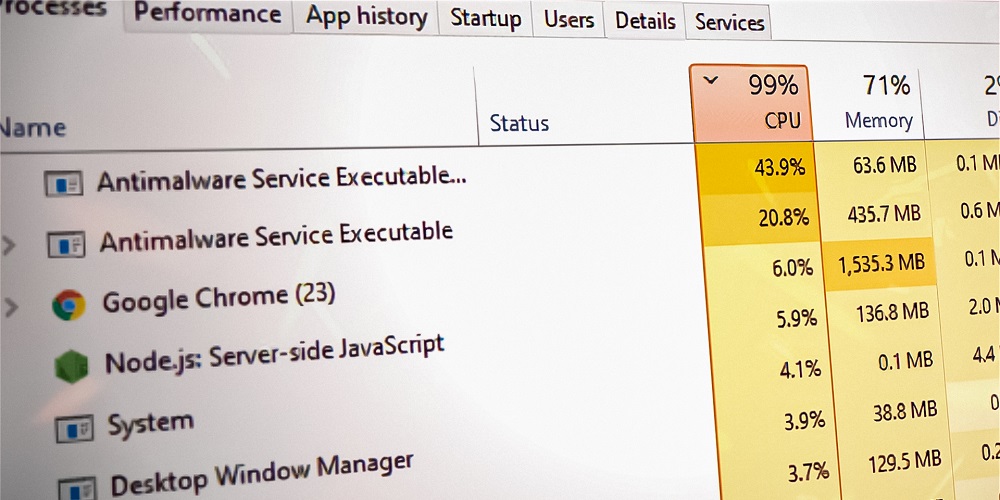
Antimalware Service Executable is a critical component of Microsoft Defender, the system’s ultimate defense against malware and virus threats. Microsoft Defender runs a critical component in the background. This executable app’s filename is MsMpEng.exe. Microsoft Defender’s latest generation and components are excellent until it consumes all CPU power. This article explains Antimalware Service Executable and why it uses so much CPU.
What’s Antimalware Service Executable & How Does It Work?
Microsoft Defender was introduced as antivirus software for Windows 7 and other versions in 2006. Windows 10 was formerly known as Windows Defender. As a result, it is customary for Microsoft Defender to be included in all versions of Windows to protect your system against viruses and malware. Microsoft has exhausted all of its defenses on the matter of security. Even if Windows Defender is off, the system will ensure activation. Microsoft Defender’s compatibility with Windows 11 is quite exceptional.
Antimalware Service Executable, which runs in the background of Microsoft Defender, protects the system against malicious software. Antimalware Service Executable’s primary function is to update antivirus definitions to scan for malicious files and software. In addition, Antimalware Service Executable is a component of Microsoft Defender that monitors threats and security vulnerabilities.
The progress may be viewed in Task Manager. For example, Antimalware Service Executable is its location in the processes tab, whereas MsMpEng.exe is its name in the details tab.
Suppose you wish to examine Microsoft Defender’s defense against current threats and viruses. Here, it would be best if you took this path.
1 – Navigate to Windows > Settings > Privacy and Security.
2 – Click Windows Security.
3 – Now Open Windows Security.
4 – This section provides Virus & Threat Protection.
Why Does It Take High CPU Usage
That is as straightforward as adding two plus two. It checks all your files and apps in the background for malware and virus threats. In addition to scanning your files and software, it also scans its own. Thus, it consumes the entire CPU to deliver exhaustive information. While running on a powerful CPU, you may see app crashes, lags, hangs, and other problems. In contrast, using a CPU or other resources to do thorough virus scanning is acceptable. Inconveniently, you cannot use your system while Microsoft Defender consumes full CPU resources. Scheduling the scanning procedure to do everything sequentially is one of the greatest practices.
Is It Possible To Disable Antimalware Service Executable?
An antivirus tool benefits us and the system, particularly a robust free tool such as Microsoft Defender. Even if it sometimes consumes entire CPU power, it is essential to keep it installed until you have decided on other antivirus software. There is no way to disable it permanently. Yeah, you may let it rest for some time. Microsoft Defender is incredibly sophisticated and has to be to protect the system.
Even if you disable it, Microsoft Defender will reactivate after a while if it cannot find any other antivirus software installed on your system. As previously indicated, you cannot disable it or pause for a time assist. It can only be removed by installing other antivirus software.
When you use antivirus software other than Microsoft Defender, Microsoft Defender will cease its service automatically. The system will display “You’re using other antivirus providers” in the Windows security section. Windows still permits us to use Microsoft Defender with a third-party antivirus tool if you choose to do so. Just enable its periodic scanning toggle anytime you believe it may be necessary. Technically, you will receive an additional layer of protection.
Microsoft Defender is an indispensable system utility as it has risen in strength and might. Although it may waste CPU and other resources, preserving it is always valuable.
Should I Stop Antimalware Service Executable?
If security is an issue, I advise against terminating its service. Because Windows Defender has vastly improved its capabilities and efficacy in protecting your system over time, it includes the functioning mechanism itself. Another major selling point is that this sophisticated tool is free. Unless you move to another third-party app, you must rely on it.
Conclusion:
You have adequate knowledge of what an antimalware service executable is and why it uses so much CPU. We answer all of the common questions about it. If you still have a query, please ask in the comment section.









